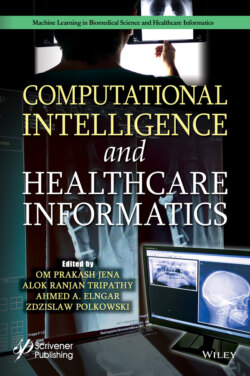Читать книгу Computational Intelligence and Healthcare Informatics - Группа авторов - Страница 36
References
Оглавление1. James, M., Michael, C., Brad, B., Jacques, B., Big Data: The Next Frontier for Innovation, Competition, and Productivity, McKinsey Global Institute, New York, NY, 2011.
2. Al-Jarrah, O.Y., Yoo, P.D., Muhaidat, S., Karagiannidis, G.K., Taha, K., Efficient machine learning for big data: A review. Big Data Res., 2, 3, 87–93, Sep. 2015.
3. Beyer, M.A. and Laney, D., The importance of ‘big data’: A definition, Gartner Research, Stamford, CT, USA, Tech. Rep. G00235055, 2012.
4. Xing, L., Krupinski, E.A., Cai, J., Artificial intelligence will soon change the landscape of medical physics research and practice. Med. Phys., 45, 5, 1791–1793, 2018.
5. Deo, R.C., Machine Learning in Medicine. Circulation, 132, 20, 1920–1930, 2015.
6. Kannel, W.B., Doyle, J.T., McNamara, P.M., Quickenton, P., Gordon, T., Precursors of sudden coronary death. Factors related to the incidence of sudden death. Circulation, 51, 606–613, 1975, [PubMed] [Google Scholar].
7. Lip, G.Y.H., Nieuwlaat, R., Pisters, R., Lane, D.A., Crijns, H.J.G.M., Refining clinical risk stratification for predicting stroke and thromboembolism in atrial fibrillation using a novel risk factor-based approach: the euro heart survey on atrial fibrillation. Chest, 137, 263–272, 2010, [PubMed] [Google Scholar].
8. O’Mahony, C., Jichi, F., Pavlou, M., Monserrat, L., Anastasakis, A., Rapezzi, C., Biagini, E., Gimeno, J.R., Limongelli, G., McKenna, W.J., Omar, R.Z., Elliott, P.M., A novel clinical risk prediction model for sudden cardiac death in hypertrophic cardiomyopathy (HCM risk-SCD). Eur. Heart J., 35, 2010–2020, 2014, [PubMed] [Google Scholar].
9. National Research Council (US), Committee on A Framework for Developing a New Taxonomy of Disease, in: Toward Precision Medicine: Building a Knowledge Network for Biomedical Research and a New Taxonomy of Disease, National Academies Press (US), Washington (DC), 2011, [PubMed] [Google Scholar].
10. Woodruff, P.G., Modrek, B., Choy, D.F., Jia, G., Abbas, A.R., Ellwanger, A., Koth, L.L., Arron, J.R., Fahy, J.V., T-helper type 2-driven inflammation defines major subphenotypes of asthma. Am. J. Respir. Crit. Care Med., 180, 388–395, 2009, [PMC free article] [PubMed] [Google Scholar].
11. Corren, J., Lemanske, R.F., Hanania, N.A., Korenblat, P.E., Parsey, M.V., Arron, J.R., Harris, J.M., Scheerens, H., Wu, L.C., Su, Z., Mosesova, S., Eisner, M.D., Bohen, S.P., Matthews, J.G., Lebrikizumab treatment in adults with asthma. N. Engl. J. Med., 365, 1088–1098, 2011, [PubMed] [Google Scholar].
12. Laine, S. and Aila, T., Temporal ensembling for semi-supervised learning, in: International Conference on Learning Representations, 2017.
13. Cheplygina, V., d. Bruijne, M., Pluim, J.P.W., Not-so-supervised: a survey of semi-supervised, multi-instance, and transfer learning in medical image analysis. Medical Image Analysis, 54, 280–296, 2019.
14. Bai, W., Oktay, O., Sinclair, M., Suzuki, H., Rajchl, M., Tarroni, G., Glocker, B., King, A., Matthews, P.M., Rueckert, D., Semisupervised learning for network-based cardiac mr image segmentation, in: Medical Image Computing and Comput.-Assisted Intervention, pp. 253–260, Springer, Heidelberg, 2017.
15. Zhang, Y., Yang, L., Chen, J., Fredericksen, M., Hughes, D.P., Chen, D.Z., Deep adversarial networks for biomedical image segmentation utilizing unannotated images, in: Medical Image Computing and Comput.-Assisted Intervention, pp. 408–416, Springer, 2017.
16. Sun, W., Tseng, T.B., Zhang, J., Qian, W., Computerized breast cancer analysis system using-three stage semi-supervised learning method. Comput. Methods Programs Biomed., 135, 77–88, 2016.
17. Xia, Y., Liu, F., Yang, D., Cai, J., Yu, L., Zhu, Z., Xu, D., Yuille, A., Roth, H., 3d semi-supervised learning with uncertainty-aware multiview co-training, in: IEEE Winter Conf. Appl. Comput. Vis., 2020.
18. Zhao, Y., Zeng, D., Socinski, M.A., Kosorok, M.R., Reinforcement learning strategies for clinical trials in nonsmall cell lung cancer. Biometrics, 67, 4, 1422–33, 2011 Dec.
19. Pineau, J., Guez, A., Vincent, R., Panuccio, G., Avoli, M., Treating epilepsy via adaptive neurostimulation: a reinforcement learning approach. Int. J. Neural Syst., 19, 4, 227–40, 2009.
20. Liu, Y., Logan, B., Liu, N., Xu, Z., Tang, J., Wang, Y., Deep reinforcement learning for dynamic treatment regimes on medical registry data. 2017 IEEE International Conference on Healthcare Informatics (ICHI), 2017 Aug., pp. 380–5.
21. Raghu, A., Komorowski, M., Ahmed, I., Celi, L.A., Szolovits, P., Ghassemi, M., Deep reinforcement learning for sepsis treatment. CoRR, 2017, abs/1711.09602.
22. https://news.stanford.edu/2017/01/25/artificial-intelligence-used-identify-skin-cancer (dated: 13-09-2020)
23. Gulshan, V., Peng, L., Coram, M. et al., Development and Validation of a Deep Learning Algorithm for Detection of Diabetic Retinopathy in Retinal Fundus Photographs. JAMA, 316, 22, 2402–2410, 2016.
24. Dash, S.S., Big data in healthcare: management, analysis and future prospects. J. Big Data, 6, 54, 2019.
25. Johnston, L.R. and P.L., Suboptimal response to clopidogrel and the effect of prasugrel in acute coronary syndromes. Int. J. Cardiol., 995–999, 2013.
26. Sean Chia, J.H., SAR by kinetics for drug discovery in protein misfolding diseases. PNAS, 2018.
1 *Corresponding author: nahidsami187@gmail.com
